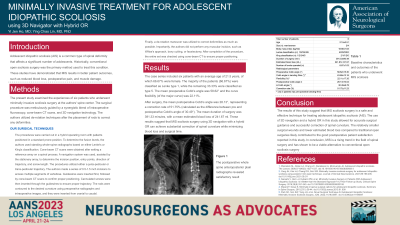Minimally Invasive Treatment for Adolescent Idiopathic Scoliosis using 3D Navigator with Hybrid OR
Minimally Invasive Treatment for Adolescent Idiopathic Scoliosis Using 3D Navigator with Hybrid OR
Friday, April 21, 2023


Yi Jen Ho, MD (she/her/hers)
Neurosurgery resident
Hualien Tzu Chi Hospital, Buddhist Tzu Chi Medical Foundation, Hualien, Taiwan
ePoster Presenter(s)
Introduction: Adolescent idiopathic scoliosis(AIS), the most common type of scoliosis, is usually treated with conventional open scoliosis surgery which was thought to be easier to achieve satisfactory deformity correction. However, it was accompanied with significant blood loss, postoperative pain, paraspinal muscle destruction, high infection rates and bigger incisions. Minimal invasive surgery(MIS) has become a rising trend in various fields of spinal surgery, including disc herniation, stenosis and deformity. Recent studies also suggested MIS has shown to be equivalent and sometimes superior compared to open techniques in spinal deformity
Methods: The aim of this study is to analyze and review the radiologic and clinical outcomes of minimally invasive scoliosis surgery using 3D navigation with hybrid OR for AIS patients in our spine center. Six patients underwent MIS scoliosis surgery. Entry points, skin incision point, length of screws were decided using intraoperative fluoroscopy, cone beam CT which then merged with navigation. We repeated CT after guide wires were in place before actual screws insertion. We used de-rotation maneuvers after rod-placement. Several intra-operative CTs were performed to guarantee the safety and the position of pedicle screws before wounds closure.
Results: The patients’ average age was 21.5 years-old. 66.67% of them were female. 66.67% of them were in Lenke classification type 1 and 33.33% were in type 5. Mean preoperative Cobb's angle was 58.62°. The curve flexibility (major curve) was 22.11%. Postoperative Cobb’s angle was 28.13°. Pre and postoperative difference of Cobb’s angle was 30.49° with a correction rate of 51.75. Mean duration of surgery was 391.33 minutes. Mean estimated blood loss was 241.67ml. There was no major complication or neurological deficit.
Conclusion : MIS scoliosis surgery is a safe and convenient techniques to treat adolescent idiopathic surgery. It was also associated with good postoperative patients’ satisfaction for its relatively smaller surgical wounds and less postoperative pain.
Methods: The aim of this study is to analyze and review the radiologic and clinical outcomes of minimally invasive scoliosis surgery using 3D navigation with hybrid OR for AIS patients in our spine center. Six patients underwent MIS scoliosis surgery. Entry points, skin incision point, length of screws were decided using intraoperative fluoroscopy, cone beam CT which then merged with navigation. We repeated CT after guide wires were in place before actual screws insertion. We used de-rotation maneuvers after rod-placement. Several intra-operative CTs were performed to guarantee the safety and the position of pedicle screws before wounds closure.
Results: The patients’ average age was 21.5 years-old. 66.67% of them were female. 66.67% of them were in Lenke classification type 1 and 33.33% were in type 5. Mean preoperative Cobb's angle was 58.62°. The curve flexibility (major curve) was 22.11%. Postoperative Cobb’s angle was 28.13°. Pre and postoperative difference of Cobb’s angle was 30.49° with a correction rate of 51.75. Mean duration of surgery was 391.33 minutes. Mean estimated blood loss was 241.67ml. There was no major complication or neurological deficit.
Conclusion : MIS scoliosis surgery is a safe and convenient techniques to treat adolescent idiopathic surgery. It was also associated with good postoperative patients’ satisfaction for its relatively smaller surgical wounds and less postoperative pain.
